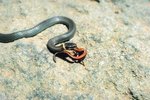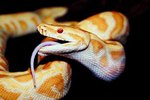
Bullsnakes (Pituophis catenifer sayi) are a subspecies of gopher snake. These sizable, nonvenomous constrictors have notably sturdy and robust physiques. Bullsnakes are native to North America and are prevalent in both the United States' southern and western regions. Some also inhabit Canada and Mexico. They are part of the family Colubridae.
Basic Details
Bullsnakes generally achieve lengths of anywhere from 4 to 8 feet. Their bodies are usually beige, yellow or off-white in color, and they are covered with many big black, reddish-brown or brown spots. The lower parts of their bodies are light yellow. Bullsnakes' scales protrude prominently, so their skin has a coarse look to it. They reside within burrows and exist in a diverse array of habitat types, including mountains, grasslands, prairies and agricultural sites. When they are frightened or shocked, their tails tend to quiver. Bullsnakes mate from March to April each year.
Food in Nature
Tiny rodents are a big part of the bullsnake diet. Because of this, they're often thought of as being immensely helpful for rodent pest management. Wee mammals in general are a meal staple for them -- think prairie dogs, cotton rats, rabbits and squirrels. They commonly dine on birds and their eggs. Lizards and frogs also sometimes appear on their menus. Their mode of attack on their prey is constriction -- tightly squeezing the animals until breathing ceases. They generally seek out food in daylight. When it's especially hot out, however, they sometimes hunt at night instead.
Duck Eggs
Although many people often appreciate bullsnakes for helping to minimize frustratingly high rodent populations, some individuals involved in the game farm industry are troubled by their penchants for feasting on duck eggs.
Captive Diet
Bullsnakes are often kept as pets. These reptiles adore eating. As pets in homes, their diets aren't too different from their diets in the wild. When they're juveniles, they tend to take in a lot of little mice, usually two to three in one sitting. In adulthood, bullsnakes usually either go for tinier rats or fully grown mice. Once they reach between 2 and 3 years in age, they are usually ready to start on bigger rats, but only one at a time. Bullsnakes that live in zoos also eat lots of mice. Chicks are frequently added into bullsnake zoo diets. If you have any specific questions regarding proper feeding of bullsnakes, speak to an exotic veterinarian before you start.
References
- Missouri Department of Conservation: Bullsnake
- National Geographic: Bull Snake
- Yellowstone National Park: Bullsnake
- Texas Parks & Wildlife: Bullsnake
- University of Nebraska - Lincoln The Herpetology Database: Bull Snake
- Connecticut's Beardsley Zoo: Bull Snake
- Cosley Zoo: Common Bullsnake
- ReptileChannel.com: Bullsnakes
- ReptileChannel.com: Bullsnake Reptiles
Photo Credits
-
Jupiterimages/Comstock/Getty Images




